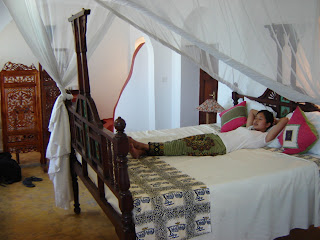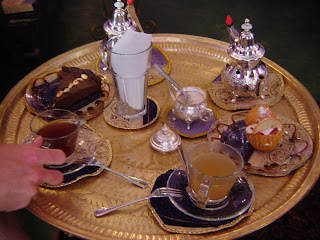August 18th, 2013
Well, Kim and I have made it back home, but I thought that I
should write another post about the rest of our time on Zanzibar. After Chumbe Island, we stayed one
final night in Stone Town, the capital of the island. Stone Town is a very unique city, which has ancient Swahili
(African) roots, but because of its location on the spice trade routes, it was
controlled at various times by Omani sultans, a British protectorate, and the
Tanzanian government. Currently,
Zanzibar is a semi-autonomous island associated with Tanzania.
Our hotel, the Swahili House, was quite old and quite
beautiful. It dates back to the 19th
century, when it was the private residence of one of the sultan’s
families. It has been converted
into a fine hotel with real Arab and Swahili flair. The bed was quite beautifully carved, and the hallway had
very clear Arabic influences.
On the rooftop, there was a very nice restaurant and
bar. The Swahili House is one of
the tallest buildings in Stone Town, so the restaurant had a commanding view of
most of the city.
One interesting thing about dining on the roof was that you
could hear the adhan (Muslim call to
prayer) from the loudspeakers of the mosques all around the city. It was really quite fun to hear the
first mosque begin with “Allahu Akbar” (God is Great), then ten seconds later a second mosque would
start. Soon, the whole city is
filled with the cacophony of dozens of Muezzin calling the faithful to prayer.
The city of Stone Town is a stunning labyrinth of streets
and alleyways that almost seem designed to confuse pedestrians. Some of the streets are so narrow that
scooters cannot even drive through.
They twist and turn so that you can lose direction quite easily. The only way to navigate is to go vaguely
by the direction of the sun, but even this is challenging, since the sun is
often not visible due to the proximity of rather tall buildings along the
narrow streets. Beyond this, there
are no street names posted anywhere.
I wonder how people get their mail…Here is a map of Stone Town to give
you a sense of the layout of the city.
This is what the streets looked like. Notice the very beautiful headscarf
that the woman is wearing in this photo.
The market was also a sight to behold. Zanzibar has a very unique aroma. The main scent is that of spices and
musk. However, at times you might
smell coconut (if someone is cutting open coconuts nearby), or cooking meat, or
if you’re really lucky, fresh fish sitting in the sun! The market was really bustling with
activity. It was so fun to just
stand around and watch the people in the market. We still found the courage to haggle with some of the locals
over spices. The spices in
Zanzibar are extremely good and extremely cheap. We bought about $50 worth of saffron (in America) for around
$10. Here are a few shots of the
market, but they really don’t fully capture the experience of being there,
unfortunately.
In the afternoon, we decided to take a break from all our
shopping and wandering, so we stopped in a traditional Swahili tearoom. We had delicious spiced teas (Kim had
ginger and I had cardamom), with nice pastries. The refreshments were very good, but the ambiance really
made the experience unforgettable. Here are a couple of pictures of the
tearoom. Notice the Arabic serving
table and silver teapots.
For dinner we headed over to the Forodhani Gardens near the
port.
In the evenings, that area is famous for its street
food. Locals bring in their fresh
catch of the day and grill it to order on skewers. We ate rock lobster, prawns, barracuda, and clams with
different flatbreads (coconut was exceptionally good) and samosas.
At one point cats started to rub up against me hoping for a
bite of my seafood. Paws off my
grub, kitty!
Our meal was accompanied by sugar cane juice mixed with lime
and ginger. For those who don’t
know how this is made, there is a neat machine that grinds the sugar cane into
pulp, releasing the juice, which is then collected in your cup. Here is what the machine looks like.
For dessert, we had what is known as a “Zanzibari Pizza”,
which is a kind of stuffed pancake.
You have your choice of different toppings for your pizza (we chose
peanut butter and coconut with chocolate sauce), then they fry it on a
griddle. It was so good, because
it was crunchy on the outside but gooey from the peanut butter. Yum!
Before our flight on Thursday, we had time for a little more
sight seeing, so Kim and I headed over to the Anglican Cathedral, which was
quite close to our hotel.
A little
background on the church and Zanzibar: Zanzibar was for a long time a stopover
for the slave trade. Merchants who
brought their slaves from the interior of Africa would bring them to Zanzibar
to sell primarily to Arab sultans, who were forbidden by the Quran from
enslaving Muslims. In the 19th
Century, many British missionaries came to Africa to try and abolish the slave
trade, and in 1873, Zanzibar was the last place on earth to have slavery
abolished by legal mandate. In
commemoration of this, an Anglican Church was built on the original slave
market. There is a moving tribute
to the victims of the slave trade in front of the church. Here is a picture of the monument.
The living quarters for the clergy sit right above the slave
quarters, which were stuffy, and hot, and really cramped even for ten
people. I couldn’t imagine what it
must have been like for 1000 people.
I guess that is why over 70% of slaves died before being brought to
their final destinations. See how
much Kim was sweating after two minutes.
Just imagine living there for weeks!
The Church was lovely, and a potent symbol. The altar was erected at the exact spot
where the whipping post once stood.
On the way back, we visited the biggest mosque on the
island. Though Islam is the
primary religion on Zanzibar, it is interesting to see that the people are
quite accepting of other religions.
I guess that comes from centuries of multicultural groups living
together. You can see that right
behind the Anglican Church is a mosque.
I can think of no better example of how religious acceptance should be.
























No comments:
Post a Comment